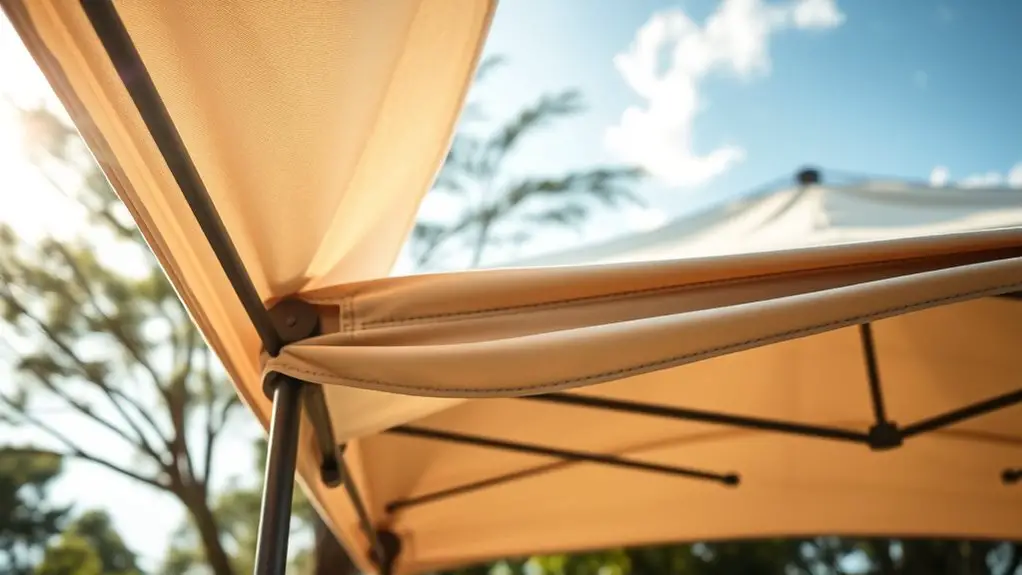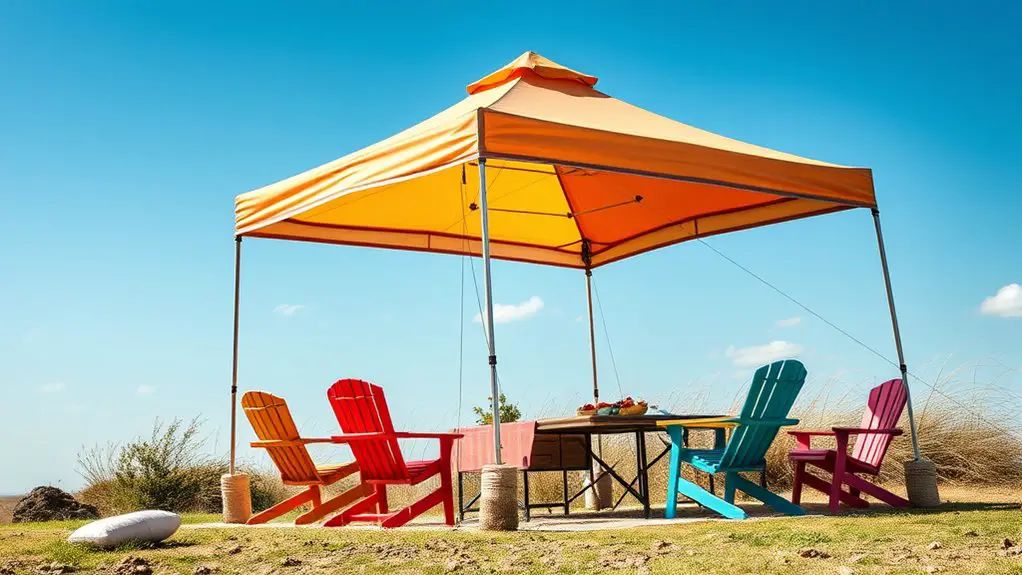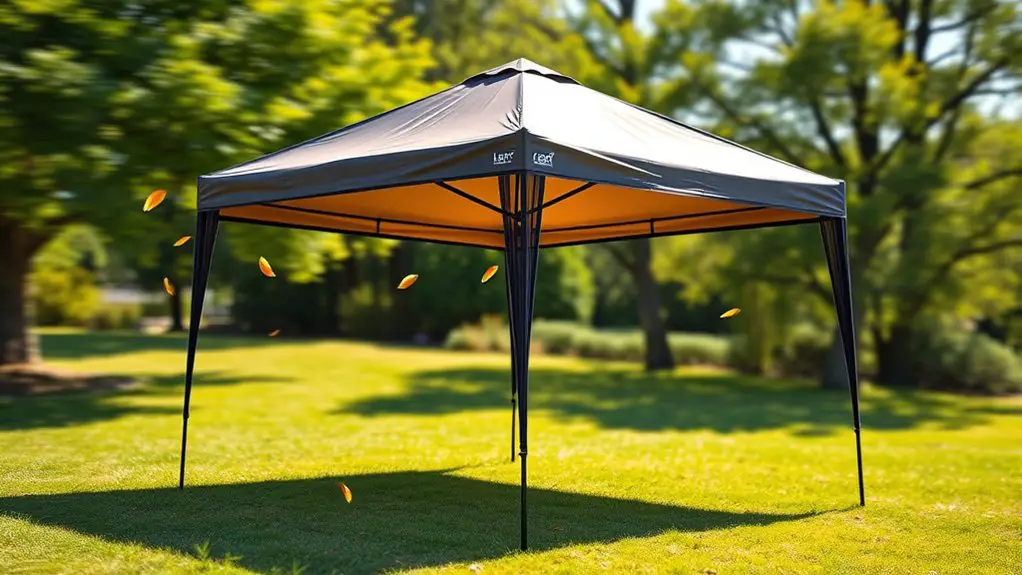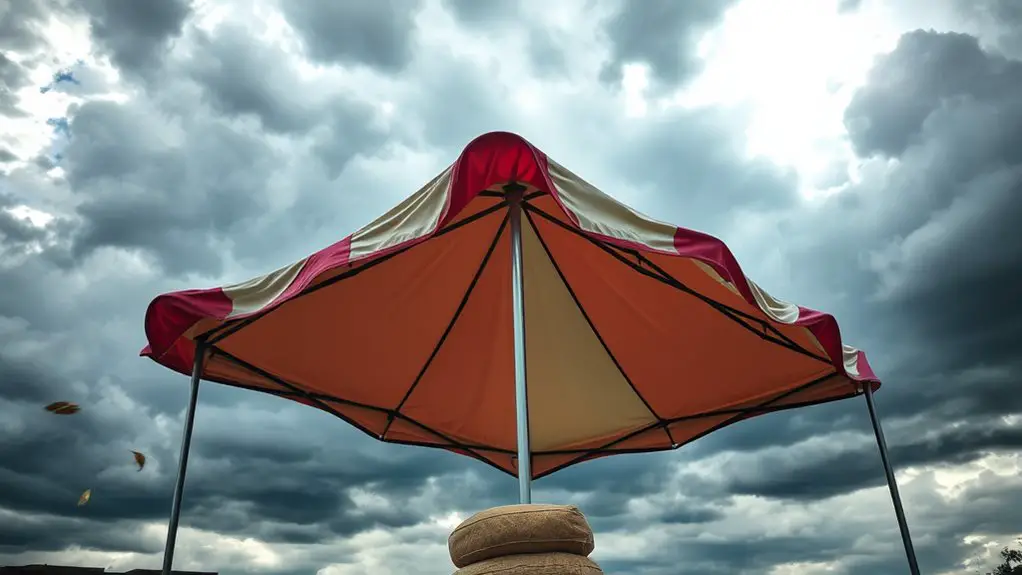Pop-up gazebos can be sturdy in windy conditions if designed with strong materials and secured properly. Look for models with reinforced frames and high-denier polyester canopies for enhanced durability. Employ effective anchoring techniques like stakes or weighted bags, and position the gazebo away from prevailing winds. Regular inspections and adjustments during use also contribute to stability. By considering specific brands and models known for wind resistance, you can guarantee better performance in challenging weather. More insights await you.
Understanding the Structure of Pop-Up Gazebos

Although pop-up gazebos are designed for convenience and quick assembly, their structural components greatly influence their stability in windy conditions. When selecting a gazebo, you’ll want to evaluate various pop-up gazebo designs that integrate robust materials and engineering techniques. Sturdy frames, often crafted from aluminum or steel, provide essential strength and support. Look for models featuring reinforced joints and cross-bracing, which enhance overall rigidity.
Additionally, effective wind resistance features are vital; some gazebos come with built-in anchor systems or weighted bases that help secure the structure against gusts. Canopy materials also play a role; those made from high-denier polyester are more durable and less likely to tear in adverse weather. By understanding these structural elements, you can choose a pop-up gazebo that not only meets your aesthetic needs but also offers reliable performance, letting you enjoy outdoor freedom without worry. Furthermore, selecting a gazebo with a higher wind rating can significantly improve its ability to withstand gusts and provide safety during use.
Factors Influencing Stability in Wind
Several key factors influence the stability of pop-up gazebos in windy conditions. One major consideration is wind speed; as it increases, the risk of your gazebo becoming unstable rises dramatically. Typically, gazebos are rated for specific wind speeds, so knowing these limits helps you gauge safety.
Another essential factor is anchor types. The effectiveness of your anchors can vary greatly; stakes, weights, and tie-downs all serve different purposes. For instance, heavy-duty stakes might perform well in soft ground, while weights are more effective on hard surfaces.
You should also consider the gazebo’s design and materials. Stronger frames offer better resistance to wind forces, while lighter materials can be more susceptible to lift. By understanding these factors, you can make informed choices that enhance your gazebo’s stability during windy conditions, allowing you to enjoy your outdoor space with confidence. Additionally, selecting a gazebo specifically designed for wind resistance can significantly improve its performance in challenging conditions.
Tips for Securing Your Pop-Up Gazebo

When securing your pop-up gazebo, it’s essential to implement a multi-faceted approach to guarantee stability in windy conditions. Start by employing effective anchoring techniques. Use stakes or weighted bags specifically designed for gazebos to tether the structure firmly to the ground. Verify that the anchors are driven deep or filled adequately to withstand gusts.
Next, pay attention to weight distribution. Place heavier items, like coolers or furniture, strategically inside the gazebo to lower the center of gravity and minimize the risk of tipping. Avoid placing all heavy items on one side, as this can create an imbalance. Additionally, consider using anchoring techniques such as storm straps or corkscrew-shaped pegs to enhance the stability of your gazebo in strong winds.
Lastly, always keep an eye on weather forecasts. If winds are forecasted to rise considerably, consider disassembling the gazebo as a precaution. By following these tips, you can enjoy your outdoor space without worrying about your gazebo’s stability during blustery conditions.
Materials and Design Considerations
When selecting a pop-up gazebo, you’ll want to take into account the frame strength and stability, as these factors directly impact its performance in windy conditions. Additionally, the fabric’s durability and resistance to tearing and UV exposure are essential for long-term use. Understanding these materials and design aspects will help you choose a gazebo that can withstand challenging weather. A gazebo with a wind resistance rating is crucial for ensuring safety during gusty conditions.
Frame Strength and Stability
The frame strength and stability of pop-up gazebos greatly depend on the materials and design choices made by manufacturers. When evaluating frame design, consider options like aluminum or steel, as they offer different levels of durability and weight. Aluminum frames are lightweight and rust-resistant, but may lack the strength of steel, which provides better stability in windy conditions. Stability testing is essential; look for models that have undergone rigorous evaluations to guarantee they can withstand gusts. Additionally, features like reinforced joints and cross-bracing enhance overall stability. By prioritizing robust materials and thoughtful design, you can enjoy your outdoor space without worrying about your gazebo collapsing in the wind, giving you the freedom to relax and entertain.
Fabric Durability and Resistance
While you may appreciate the aesthetic appeal of a pop-up gazebo, the durability and resistance of its fabric are essential for withstanding various weather conditions, especially wind. Selecting the right material can greatly impact your gazebo’s performance. Look for fabrics that offer high weather resistance and breathability to guarantee comfort and longevity.
| Fabric Type | Weather Resistance | Fabric Breathability |
|---|---|---|
| Polyester | High | Moderate |
| Canvas | Very High | Low |
| Nylon | Moderate | High |
| PVC Coated | Very High | Low |
Choosing the right fabric combination not only enhances aesthetics but also provides you with the freedom to enjoy your outdoor space without worrying about sudden weather changes.
Recommended Brands and Models for Wind Resistance

When selecting a pop-up gazebo for windy conditions, it’s essential to identify models specifically engineered for wind resistance. You’ll want to take into account key features such as reinforced frames, high-quality materials, and secure anchoring systems. Additionally, comparing brand ratings can help you make an informed choice about which models consistently perform well in adverse weather.
Best Wind-Resistant Models
Choosing the right pop-up gazebo for windy conditions can greatly impact your outdoor experience. When looking for the best wind-resistant models, focus on options that incorporate robust wind resistant features. Brands like Coleman and Abba Patio offer structures designed with reinforced frames and durable canopies. A heavier gazebo weight often signifies stability; consider models weighing at least 50 pounds for improved resistance. The Eurmax 10×10 canopies, for instance, come equipped with wind vents that reduce uplift, while the Quik Shade offers sturdy sidewalls for extra protection. Investing in these models not only guarantees safety but also enhances your freedom to enjoy outdoor activities, even when the winds pick up. Always check user reviews for real-world performance insights.
Key Features to Consider
Understanding the key features of pop-up gazebos can greatly enhance your decision-making process, especially for windy conditions. Focus on the frame material; aluminum or steel provides superior strength and durability. Look for models with reinforced corners and cross-bracing for added stability. Weather resistance is essential—choose canopies made from high-quality, UV-resistant fabric that can withstand rain and gusts. Also, consider the anchoring system; secure stakes or sandbags can make a significant difference in preventing lift-off. User reviews are invaluable; they often highlight real-world performance in windy environments. By prioritizing these features, you can select a gazebo that not only offers shelter but also stands resilient against the elements, giving you the freedom to enjoy outdoor activities without worry.
Brand Comparisons and Ratings
While many brands offer pop-up gazebos, not all are created equal when it comes to withstanding windy conditions. You’ll want to evaluate brand durability and user experiences to make an informed choice. Here’s a quick comparison of some recommended brands:
| Brand | Durability Rating | User Experiences |
|---|---|---|
| Coleman | High | Very satisfied with stability in winds |
| EZ-Up | Medium | Good, but some issues in extreme conditions |
| Quik Shade | High | Excellent feedback on durability |
| Abba Patio | Medium | Generally reliable but check reviews |
| Outsunny | Low | Users report frequent issues in wind |
Choosing the right brand can make all the difference in enjoying your outdoor freedom, even in breezy conditions.
Best Practices for Use in Windy Conditions
When setting up a pop-up gazebo in windy conditions, it’s important to take specific precautions to guarantee stability and safety. Start by choosing a sheltered location, if possible, to minimize wind exposure. Use high-quality gazebo accessories like weighted bags or stakes to anchor your structure firmly to the ground. Confirm that all canopy corners are properly secured, as loose flaps can catch the wind and create a lifting effect.
Reflect on positioning the gazebo with its open side facing away from the prevailing wind direction, reducing the wind’s impact. Regularly check the forecast; if winds exceed 20 mph, it’s wise to think about postponing your event. Always keep an eye on the gazebo during use, as sudden gusts can occur. Additionally, consider multiple securing methods to further enhance stability against strong winds. Following these best practices helps you enjoy your outdoor space without compromising safety in windy conditions.
Frequently Asked Questions
Can I Use a Pop-Up Gazebo on Uneven Ground?
You might worry about stability concerns on uneven ground, but with proper ground preparation—like leveling surfaces or using stakes—your pop-up gazebo can still provide a secure and enjoyable outdoor experience, allowing you to embrace freedom outdoors.
How Do I Clean My Pop-Up Gazebo?
To clean your pop-up gazebo, use gentle soap and water with a soft brush. For maintenance tips, regularly inspect seams and poles, ensuring they’re free from debris and damage for longevity and peak performance.
What Is the Average Lifespan of a Pop-Up Gazebo?
Did you know that a well-maintained pop-up gazebo can last anywhere from 3 to 10 years? Durability factors like materials and construction quality influence its lifespan considerably, so choose wisely to enjoy your outdoor freedom longer.
Are There Weight Limits for Pop-Up Gazebos?
Yes, pop-up gazebos often have weight limits, essential for maintaining stability. Proper weight distribution across the structure enhances its durability, preventing potential damage and ensuring a safe, enjoyable experience during your outdoor gatherings.
Can I Customize My Pop-Up Gazebo’s Appearance?
Your pop-up gazebo can be a canvas for creativity! With various customization options, you can choose design materials that reflect your personality and style, ensuring it stands out like a dazzling star at any event.

